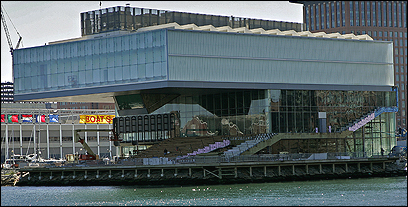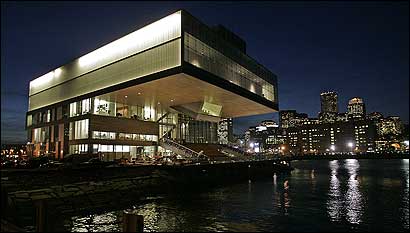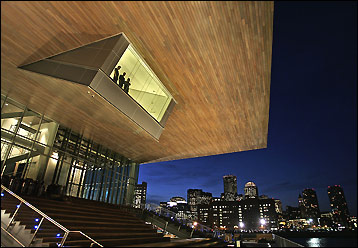L
laramaro
Guest
ICA Announces New Opening Date
From http://www.icaboston.org/Home/Information/PressReleases/New%20Press%20Release(20)The Institute of Contemporary Art Announces Opening Date, December 10, 2006
Capital Campaign Exceeds Goal, Raising an Unprecedented $65 Million
October 18, 2006
The Institute of Contemporary Art (ICA) will open its new waterfront museum on Sunday, December 10, 2006, with a free, 12-hour community day. The celebration was rescheduled due to construction delays. The ICA also announced that gifts to the capital campaign have reached $65 million, surpassing the museum's fundraising goal of $62 million.
"As we approach our grand opening, we are enormously pleased to announce the tremendous success of the campaign and the unwavering support of our community," said Jill Medvedow, Director of the ICA. "Our new museum embodies all of our artistic, architectural, and civic aspirations, enabling us to connect contemporary art to the wider culture, create opportunities for artists, and teach and inspire our young people through the arts."
The ICA is the first art museum built in Boston in nearly 100 years and the only museum in the city devoted exclusively to exhibiting and acquiring contemporary art. It is also renowned architects Diller Scofidio + Renfro's first building in the United States.
The iconic new museum features a dramatic folding ribbon form and a cantilever that extends to the water's edge. The 65,000-square-foot building triples the exhibition space of the previous facility and enables the museum to feature exhibitions of a size and scope never before possible. The ICA will present up to four exhibitions at a time, including thematic and solo exhibitions, showcases for emerging artists, and the first permanent collection in the museum's 70-year history. A 325-seat theater and mediatheque enable the museum to expand its offerings in the performing arts, film, media, and technology.
On Grand Opening Sunday, visitors will be admitted free of charge from 9 am to 9 pm to tour the new building and view the inaugural exhibitions. Festivities will include family-oriented activities and live performances. The Grand Opening of the ICA is sponsored by Bank of America, John Hancock, and State Street Corporation. Grand Opening Sunday is presented by Target. (Seating for performances is limited; tickets are required. Tickets are free and are available on a first-come, first-served basis on the day of event at the admissions desk.)
Capital Campaign
In April 2000, the ICA Boston launched the most ambitious capital campaign in its history to build, endow, and program the new waterfront museum. The campaign has galvanized the Boston community from leading philanthropists to teens participating in ICA programs, from major corporations to family foundations. Lead gifts have come from longtime supporters as well as from new donors, greatly increasing the museum's base of support. Over 770 gifts were received from more than 20 states, including 22 gifts of more than $1 million.
ICA trustee Barbara Lee kicked off the campaign with a lead gift of $5 million from the Barbara Lee Family Foundation, which donated a total of $6.75 million. "The ICA's donors have helped make history on the Boston waterfront," said Lee, Honorary Chair of the capital campaign, who led the fundraising effort with Co-Chairs Robert Davoli and Ellen Poss. "The leadership of our trustees?who generously contributed more than $33 million?and the support of art lovers and community leaders in Boston and beyond have made this visionary project a reality."
Named spaces and programs at the ICA include: Bank of America Art Lab; Putnam Investments Plaza; State Street Corporation Lobby; Charles and Fran Rodgers Education Center; Paul and Phyllis Fireman Family Digital Studio; Glass Elevator, Gift of Anthony and Beth Terrana; Barbara Lee Family Foundation Theater; Louis I. Kane Board Room; Poss Family Mediatheque; Paul and Catherine Buttenwieser Gallery; Kim and Jim Pallotta Gallery; and John Hancock Teen Education Programs.
The ICA raised more than $7.5 million from the corporate community, including gifts from Bank of America, John Hancock Financial Services, Putnam Investments, and State Street Corporation, a 250-fold increase in corporate contributions since 2000. Foundation giving also was a key factor to the success of the campaign, with a $3 million anonymous gift and support from the Kresge Foundation, which made a $1.5 million challenge grant to the ICA to increase its donor base. Other significant gifts include grants from Jane's Trust, the Paul and Phyllis Fireman Foundation, Hunt Alternatives Fund, and The Lynch Foundation.
General Information
The Institute of Contemporary Art's new waterfront facility is located at 100 Northern Avenue in Boston. The museum will be open Tuesday and Wednesday, 10 am ? 5 pm; Thursday and Friday, 10 am ? 9 pm; and Saturday and Sunday, 10 am ? 5 pm. Admission is $12 adults, $10 college students and seniors, and free for members and children 17 and under. Admission is also free for all visitors on Target Free Thursday Nights from 5 pm ? 9 pm. For more information, call 617-478-3100.
The ICA's official media sponsors are The Boston Globe, WHDH-TV, and WBUR-FM.
The ICA's official performing arts media sponsor is The Boston Phoenix.




